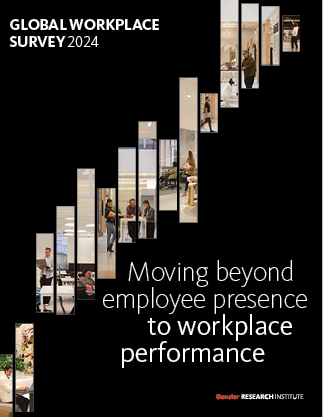Gensler’s Global Workplace Survey of more than 16,000 office workers across 15 countries and 10 industries reveals that companies need to adopt a people-first lens to evaluate the performance of their workplace to drive better individual, team, and business outcomes. This provides an opportunity to reexamine how we measure workplace performance.
In this report, we propose a new precedent for measuring workplace performance. Workplace performance is no longer defined only by building efficiency or space effectiveness; it is also measured by the emotional response to space — the workplace experience. This study highlights the shift from real estate occupancy to people-centric performance to understand the impact of space on how employees work and feel in the workplace. In doing so, it unlocks the potential to design workplaces that can yield positive outcomes for individuals, teams, and organizations.
Our 2024 Global Workplace report reveals how and where employees work today. The study examines top performers at individual, team, and organizational levels, and highlights what comprises a high-performing workplace within and beyond the office — including findings at the building and neighborhood scales. By evaluating the workplace in its wider context, we identify where design can elevate a workplace from good to great to exceptional.
How and where employees work varies across country, industry, age, and role.
We measure how people work across five work modes.
Gensler has continuously measured how people work for almost 20 years. We analyze how employees work across five work modes: working alone, working with others in-person, working with others virtually, learning and professional development, and socializing, connecting, and networking. Work modes adapt with global evolution in worker behavior and technological advancements such as virtual working. This foundational research provides new insights into the changing nature of work and employee expectations.
IN-PERSON
Today’s workplaces must evolve with employee work patterns.
Understanding how and where employees work and what they value is essential to redefine how to measure high-performing workplaces. Gensler’s Global Workplace Survey reveals how employees work differently across demographics varying by country and industry, as well as age and role. This insight is the basis from which we can design great, and even exceptional, workplaces that respond to the current needs of office workers.
Global Workplace Survey 2024 Methodology
The Gensler Research Institute conducted an anonymous, panel-based survey of 16,040 full-time office workers across 15 countries between October 31, 2023 and January 29, 2024. The survey was deployed using a third-party panel provider. At the time of data collection, all respondents were required to be full-time employed knowledge workers and to work for a company, organization, or firm of at least 100+ employees, within 10 designated industry segments. Respondents were also required to work in an office environment at least some of the time. Respondents represented a broad cross-section of demographics, including job role, company size, age, commuting distances, living situation, and geographical location across six global regions.

Download Gensler’s Global Workplace Survey 2024 to learn how to convert our knowledge of how employees work into design outcomes that can elevate workplace performance from good to great.